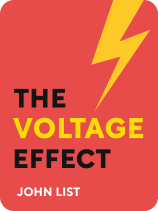

This article is an excerpt from the Shortform book guide to "The Voltage Effect" by John A. List. Shortform has the world's best summaries and analyses of books you should be reading.
Like this article? Sign up for a free trial here.
What is the spillover effect? How does it impact your ability to scale an idea?
In The Voltage Effect, economist and professor John A. List provides advice on how to figure out if a particular idea will scale. In order to do this effectively, you must understand the spillover effect, recognize it when it’s happening, and manage it well.
Read more to learn how to deal with the unintended consequences of scaling your idea.
The Spillover Effect
As you try to scale your idea, it helps if you understand the spillover effect. What is the spillover effect? List notes that, at scale, ideas often produce unintended effects, both positive and negative. Failing to account for the potential negative effects of scaling can prevent you from successfully scaling your ideas.
(Shortform notes: In addition to impacting your idea’s scalability, unintended consequences can also impact the world around you. For instance, as your company scales up manufacturing, its operations may have an increased effect on the environment and the health of the surrounding area. While these kinds of unintended consequences may not necessarily affect your bottom line, they could have severe consequences. As you monitor your organization for financial consequences, be sure to look out for non-financial consequences, too.)
List notes that unintended consequences of scale often occur because markets naturally tend to stabilize after being disrupted—because of this principle, when a new product enters the market, it may experience an inflated level of success due to its price point, its novelty, or other factors. However, as suppliers of similar products adjust their prices and offerings, and consumers adjust their spending and expectations, a new product’s initial advantages can diminish, leading the new product to gradually lose steam as the market readjusts around it. As a result, ideas that initially seem to be scaling well may wind up struggling in the long run.
(Shortform note: As businesses scale up, they often standardize their procedures across their many locations to provide customers with a consistent experience. However, if your product’s advantage is a strong brand identity, standardization can cause this identity to become diluted as an unintended consequence of scale. For example, experts note that as Starbucks scaled up, it experienced a cultural crisis. After standardizing procedures across their thousands of stores, Starbucks executives found that the stores had begun to lose their identity as cozy coffee houses. Instead, they more closely resembled fast food locations.)
For example, List notes that, during his time at Uber, the company attempted to increase driver earnings by raising fares across the board. While this initially caused drivers to earn more, over time, the increased cost led riders to book fewer trips, causing driver earnings to return to their previous level as the market readjusted.
(Shortform note: Despite Uber’s rationale for keeping both fares and pay rates low, many rideshare drivers have continued to demand raises, striking and advocating for legislation that would increase their earnings. These drivers argue that pay increases are necessary to keep up with inflation. At least in part due to these protests, in March 2023, New York City’s local government passed legislation that increased rideshare driver wages within the city by about 9%. How the market will readjust remains to be seen at the time of this writing.)
The Unintended Consequences of Workplace Social Dynamics
Unintended consequences of scale can also stem from certain workplace dynamics. As you scale your organization, you’ll inevitably have to hire more employees. With an increasingly large workforce, the relative costs of social problems such as demoralization, poor communication, and employee turnover can become increasingly severe due to the effects of scale.
Suppose, for instance, that due to its demanding environment, your startup maintains a 40% annual turnover rate. Given that you only employ 10 people, this high rate of turnover likely won’t feel unmanageable, as it only equates to hiring one new employee every few months. However, suppose that your business scales up, growing in size to the point where it employs a workforce of 1,000 people. If your business maintains its high turnover rate at scale, to remain fully staffed, it will have to go through the costly and time-consuming process of hiring dozens of employees each month. While it wasn’t such a big deal when your workforce was small, at scale, managing turnover becomes exponentially more expensive.
(Shortform note: While List argues that unwanted workplace dynamics become increasingly costly at scale, some authors believe that larger organizations are often better equipped to deal with workplace toxicity than smaller organizations. These authors argue that at scale, most organizations have the resources to staff and train HR departments that can help repair broken workplaces. By contrast, in small organizations, where each member of the team is intricately involved in the day-to-day, negative workplace dynamics may be allowed to fester while other issues take precedence.)
It’s also common to run into unintended consequences of scale when adopting a new network or system at your organization. Generally, even if a new system is more efficient and effective in the long run, your organization will experience lower productivity as individuals adjust to it. At a smaller organization, these setbacks may seem relatively minor. However, at scale, even slight changes in productivity can be costly.
For example, if your organization decides to change platforms for internal communication, switching from email to a more modern platform like Slack, your workforce will likely experience a temporary dip in productivity. If your small business only deals with thousands of dollars a week, a 5% to 10% decrease in productivity isn’t such a big deal. However, if your business is operating at a larger scale, dealing with hundreds of thousands or millions of dollars each week, even a 5% change in productivity represents a large sum.
(Shortform note: While there is a short-term cost associated with switching platforms, you should also consider the opportunity cost of not switching to a new system. As experts note, whenever you choose to use one piece of technology over another, you pay an opportunity cost equal to the value of the strongest option you didn’t choose. In other words, you miss out on all the benefits the other system would have provided you. To put this in concrete terms, consider Southwest Airlines’ December 2022 meltdown. Southwest’s antiquated software caused thousands of flights to be canceled, ultimately resulting in a net loss of roughly $800 million. In this case, $800 million is the cost Southwest paid for not choosing a stronger system.)
The Unintended Consequences of Wage Transparency
A common source of unintended consequences is the organizational policy around wage transparency. According to List, wage transparency can have a variety of positive and negative effects depending on how it’s implemented in your organization. To avoid the negatives and benefit from the positives, List recommends taking a considered approach to wage transparency.
List conducted a study on the effects of wage transparency to better understand which practices produced the best results. In the study, employees worked harder when they knew how much their managers were being paid, as they aspired to get promoted and earn those wages for themselves. However, when employees knew how much other workers at the same level were being paid, they became resentful and demotivated if any of their peers were earning more than them. Based on the results of this survey, the best approach would be to let employees know what the average employee makes one step up the ladder—that way, your workforce will have something to aspire to, without knowing what their peers make in enough specificity to become resentful.
| The Many Effects of Wage Transparency As List notes, wage transparency can have both motivating and demoralizing effects within an organization, depending on its implementation. However, wage transparency can have an even wider range of effects on your workforce than List describes. In terms of additional negative effects, wage transparency may cause some of your employees to quit outright. In one organization’s survey, 5% of participants said that they’d quit their jobs if they learned someone in the same role was earning more. Staff leaving their positions could have major ramifications for your organization, especially if they’re in important roles. As a more-or-less neutral effect, experts observe that wage transparency policies often result in the flattening of earnings curves within a single role. Put simply, when wage transparency policies are enacted, employees in the same role will also begin to receive similar pay. This happens as a result of supervisors attempting to prevent employees from being disgruntled at someone else’s elevated rate. In response to flattening pay curves, employees often request individual incentives, viewing bonuses as a way of both earning more and distinguishing themselves from their peers. This increased demand for bonuses based on personal performance creates a unique opportunity to create fair and transparent workplace incentives. When employees request individual incentives, experts recommend that you implement an individual performance-based bonus system that is identical for all employees in a particular role. By implementing a system that’s the same for everyone, yet still rewards individual efforts, you’ll have created a motivation system that is as egalitarian as possible. |

———End of Preview———
Like what you just read? Read the rest of the world's best book summary and analysis of John A. List's "The Voltage Effect" at Shortform.
Here's what you'll find in our full The Voltage Effect summary:
- How to take ideas from the small scale to the big stage
- The red flags that signal you may have trouble scaling up
- Strategies designed to increase your idea’s chances of success






